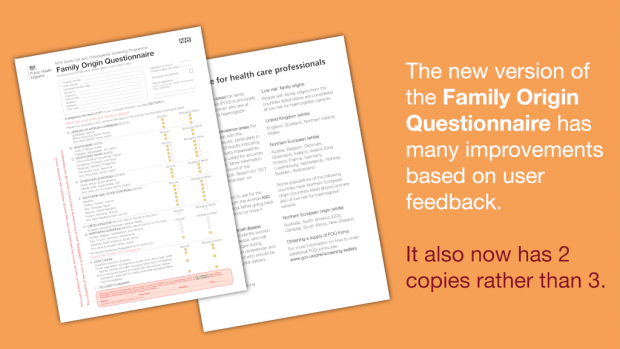We have improved and updated the family origin questionnaire (FOQ). This is an important element of the NHS Sickle Cell and Thalassaemia (SCT) Screening Programme.
Local antenatal screening services use the FOQ to help determine if an individual is likely to be a carrier of one of the serious inherited blood conditions that the SCT programme screens for.

In areas where there is a low prevalence of these conditions, health professionals use the FOQ to assess the chance that a pregnant woman is a carrier.
In high prevalence areas, they fill in the FOQ to help antenatal screening laboratory staff interpret screening results.
What we have changed
New question
'Is pregnancy the result of IVF? If yes, complete the form including SECTION H'
This new question appears at the top of the form to reinforce the need to complete section H for IVF pregnancies. Section H reminds users that if pregnancy is a result of donor egg, the mother should still be offered screening and the baby’s biological father should be invited for screening immediately. The same applies if the mother has had bone marrow transplant.
Other changes
We have:
- re-ordered some of the countries (but not re-categorised them)
- moved the hospital name from the top of form to the red box at the bottom of the form
- removed the estimated delivery date from the bottom of the form (this was a duplicated field)
- removed the reason for a decline (but do remember to tick the ‘screening test declined’ box if necessary)
- changed 'gestation at time of test' to 'gestation at time of sample' and moved this to the top of the form
- changed ‘any other origin’ to a tick box so you’re no longer required to write the country
Number of copies
When we carried out a survey recently we found that many services were either:
- using their own in-house designed forms
- using an electronic form
- about to move towards using an electronic form
Most respondents did not use all 3 copies of the form so we have reduced this to 2 copies and made savings on printing costs. Please note that services should continue to use up their current supply of the forms until they run out as they are still valid.
Reminder
Don't forget that:
- pregnant women should have their screening test by 10 weeks of pregnancy
- all antenatal SCT screening samples submitted to the laboratory must be accompanied by a completed FOQ
- women at increased risk of having a baby with sickle cell disease or thalassaemia should be offered prenatal diagnosis at or before 12 weeks of pregnancy
- women at increased risk of having a baby with sickle cell disease or thalassaemia who accept prenatal diagnosis should have the test before they reach their 13th week of pregnancy
For more information about the FOQ and how to use it in high and low prevalence areas, check out Unit 6 Understanding the screening test and the FOQ in the SCT screening e-learning module.
PHE Screening blogs
PHE Screening blogs provide up to date news from all NHS screening programmes. You can register to receive updates direct to your inbox, so there’s no need to keep checking for new blogs. If you have any questions about this blog article, or about population screening in England, please contact the PHE screening helpdesk.
4 comments
Comment by Helen Boiling posted on
Thank you for your reply Mike. I still have concerns as our demographic patient label will fill the grey box covering the EDD date section. I feel it would be helpful to still have the EDD question with the gestation at time of test. If we rely on the midwives remembering to write it without having a prompt, I have concerns that it will be missed
Comment by Andrew Anderson posted on
Dear Helen
Thank you for your comment.
We deleted EDD because the question was duplicated.
We will be able to monitor the impact of this change through our quarterly KPI ST3 completion of family origin questionnaire. We will review the data and modify the form ahead of the next print run if it is a problem.
Many thanks
Comment by Helen Boiling posted on
I am concerned that EDD is only in the demographics box at the top as it will be covered by a printed label so may mean that this information is missed off the form
Comment by Mike Harris posted on
Thank you for your enquiry. The rounded grey box for the demographic information is exactly the same width in the old and new versions (9.7cm) and there is space to the left and above the grey box to avoid covering up the EDD with the printed label. Best wishes,